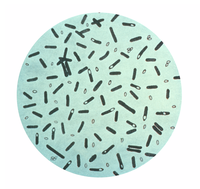
Coproduction of hydrogen and volatile fatty acid via thermophilic fermentation of sweet sorghum stalk from co-culture of Clostridium thermocellum and Clostridium thermosaccharolyticum
Sign Up to like & getrecommendations! Published in 2017 at "International Journal of Hydrogen Energy"
DOI: 10.1016/j.ijhydene.2016.09.117
Abstract: Abstract This study was focused on investigating the potential of hydrogen and volatile fatty acid (VFA) coproduction. Sweet sorghum stalks (SS) were used as substrate along with Clostridium thermocellum and Clostridium thermosaccharolyticum as production microbes.… read more here.
Keywords: hydrogen; thermocellum; clostridium; thermosaccharolyticum ... See more keywords

In vivo evolution of lactic acid hyper-tolerant Clostridium thermocellum.
Sign Up to like & getrecommendations! Published in 2021 at "New biotechnology"
DOI: 10.1016/j.nbt.2021.12.003
Abstract: Lactic acid (LA) has several applications in the food, cosmetics and pharmaceutical industries, as well as in the production of biodegradable plastic polymers, namely polylactides. Industrial production of LA is essentially based on microbial fermentation.… read more here.
Keywords: production; lactic acid; clostridium thermocellum; thermocellum ... See more keywords

CRISPR interference (CRISPRi) as transcriptional repression tool for Hungateiclostridium thermocellum DSM 1313
Sign Up to like & getrecommendations! Published in 2019 at "Microbial Biotechnology"
DOI: 10.1111/1751-7915.13516
Abstract: Hungateiclostridium thermocellum DSM 1313 has biotechnological potential as a whole‐cell biocatalyst for ethanol production using lignocellulosic renewable sources. The full exploitation of H. thermocellum has been hampered due to the lack of simple and high‐throughput… read more here.
Keywords: hungateiclostridium thermocellum; dsm 1313; crispr interference; thermocellum dsm ... See more keywords

Integrated omics analyses reveal the details of metabolic adaptation of Clostridium thermocellum to lignocellulose-derived growth inhibitors released during the deconstruction of switchgrass
Sign Up to like & getrecommendations! Published in 2017 at "Biotechnology for Biofuels"
DOI: 10.1186/s13068-016-0697-5
Abstract: BackgroundClostridium thermocellum is capable of solubilizing and converting lignocellulosic biomass into ethanol. Although much of the work-to-date has centered on characterizing this microbe’s growth on model cellulosic substrates, such as cellobiose, Avicel, or filter paper,… read more here.
Keywords: released deconstruction; inhibitors released; deconstruction; thermocellum ... See more keywords

Expression of a heat-stable NADPH-dependent alcohol dehydrogenase from Thermoanaerobacter pseudethanolicus 39E in Clostridium thermocellum 1313 results in increased hydroxymethylfurfural resistance
Sign Up to like & getrecommendations! Published in 2017 at "Biotechnology for Biofuels"
DOI: 10.1186/s13068-017-0750-z
Abstract: BackgroundResistance to deconstruction is a major limitation to the use of lignocellulosic biomass as a substrate for the production of fuels and chemicals. Consolidated bioprocessing (CBP), the use of microbes for the simultaneous hydrolysis of… read more here.
Keywords: thermoanaerobacter pseudethanolicus; pseudethanolicus 39e; thermocellum; expression ... See more keywords

Efficient whole-cell-catalyzing cellulose saccharification using engineered Clostridium thermocellum
Sign Up to like & getrecommendations! Published in 2017 at "Biotechnology for Biofuels"
DOI: 10.1186/s13068-017-0796-y
Abstract: BackgroundCost-efficient saccharification is one of the main bottlenecks for industrial lignocellulose conversion. Clostridium thermocellum naturally degrades lignocellulose efficiently using the cellulosome, a multiprotein supermolecular complex, and thus can be potentially used as a low-cost catalyst… read more here.
Keywords: whole cell; efficient whole; thermocellum; saccharification ... See more keywords

Comparative characterization of all cellulosomal cellulases from Clostridium thermocellum reveals high diversity in endoglucanase product formation essential for complex activity
Sign Up to like & getrecommendations! Published in 2017 at "Biotechnology for Biofuels"
DOI: 10.1186/s13068-017-0928-4
Abstract: BackgroundClostridium thermocellum is a paradigm for efficient cellulose degradation and a promising organism for the production of second generation biofuels. It owes its high degradation rate on cellulosic substrates to the presence of supra-molecular cellulase… read more here.
Keywords: cellulosomal cellulases; thermocellum; product; activity ... See more keywords

Comparative genomics reveals cellobiose hydrolysis mechanism of Ruminiclostridium thermocellum M3, a cellulosic saccharification bacterium
Sign Up to like & getrecommendations! Published in 2023 at "Frontiers in Microbiology"
DOI: 10.3389/fmicb.2022.1079279
Abstract: The cellulosome of Ruminiclostridium thermocellum was one of the most efficient cellulase systems in nature. However, the product of cellulose degradation by R. thermocellum is cellobiose, which leads to the feedback inhibition of cellulosome, and… read more here.
Keywords: thermocellum; ruminiclostridium thermocellum; cellulosic saccharification; cellobiose hydrolysis ... See more keywords